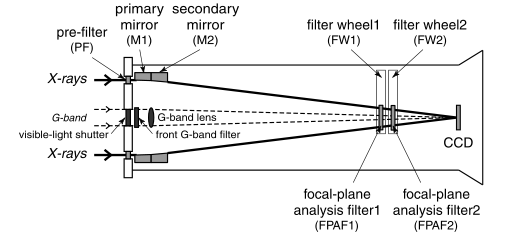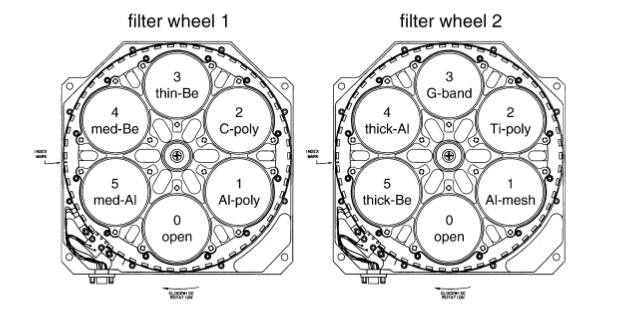Summary of XRT Data Verification tasks
6-Jan-2017 (AkT) initial version. prepared for Chunming
19-Feb-2019, slightly modified to train Suman
26-Feb-2019 added L0 movie creation note
8-Mar-2019, added XRT instrument PNGs
3-Aug-2019, added a short article, "AEC and PFB".
19-May-2022, slightly modified to train Rhiannon.
0. Hinode project and XRT
- The Hinode (Solar-B) is an international project among
Japan, US and UK.
- Hinode satellite was launched on September 23, 2006.
Hinode 10th anniv. movie
- Instruments:
- Solar Optical Telescope (SOT) --- LMSAL, NAOJ, ISAS, etc.
- EUV Imaging Spectrograph (EIS) --- MSSL, NAOJ, ISAS, etc.
- X-ray Telescope (XRT) --- SAO, NAOJ, ISAS, etc.
[click image to enlarge]
| XRT elements | Filter Wheels |
Pre-filters |

|

|

|
-
Sun-Synchronous (Polar) orbit. Period ~ 90 min.
--- enables
continuous observation for days.

Svalbard ground station (Norway) providing coverage for Hinode.
1. Hinode satellite operation and Data flow
[ OP upload ]
Observation plans are prepared by weekly duty scientists
(Chief Observers, or COs) for the 3 instruments, and a Chief planner(CP).
Prepared timelines are uploaded from Kagoshima Space Center (Japan)
by satellite operation specialists(Tobans).
- Normal mode: Tue., Thu., and Sat. (3 timelines per week).
- COs and a CP have a daily meeting (telecon) at
9:30am(JST)/6:30pm(MST)/7:30pm(MDT) to discuss observing plan
for the next timeline.
- Focus mode: 1 timeline per week (usually Tue.)
- started in 2011 to reduce costs of operation.
- usually performed during eclipse season(May-Aug) and
year-end/new-year.
- daily meeting (telecon) held on
Monday morning(Japan)/Sunday evening(US)
- transition week: transition of between normal/focus modes.
Hinode daily events page .
XRT timeline archive .
[ Data downlink ]
- Observing data and house keeping data are downloaded
at several stations in the world: e.g., Uchinoura(Japan),
Svalbard(Norway), Goldstone(USA), Kiruna(Sweden),
Perth(Australia), etc.
- All downloaded data are collected at Japan/ISAS,
and reformatted
- separate telemetry to each instrument.
- add time stamp and information for calibration.
- written in FITS format.
- Reformatted data are distributed to several data centers
in the world (SAO, MSSL, LMSAL, etc).
- Quick Look data (QL) : created as soon as the data
arrives at ISAS for the purpose of quality check and
near-real-time data prividing service (e.g., SolarMonitor).
Stored in Kootenai:/Data/XRT_QL/2017/.
- Level_0 data : created after all the data chunks are
collected from different stations. has more refined
calibration info.
Stored in Mithra:/disk/data/HINODE/xrt/level0/2017/.
2. Operation of XRT
The XRT team has a weekly team meeting (telecon) to discuss weekly
observation plan.
Every Wednesday evening (in US) at 5:30pm(MST) or 6:30pm(MDT).
Both times correspond to Thursdays, 9:30am in Japan.
You are required to attend this meeting in your DV duty week
(to give a DV report), but for other weeks it is just optional.
CO and DV of the week give brief report on their week's observation
and discuss next week plan.
We have
an XRT Homepage at Smithsonian
Astrophycial Observatory (SAO) to provide a variety of information about
the XRT.
XRT is already 15 years old, and has some instrumental problems:
- Contaminant layer accumulated on CCD and on X-ray filters.
- Stray light caused by pre-filter failure since 2012.
-
- X-band anntenna (for data downlink) down in 2008.
- Attitude Control System problem (Star Tracker down) in 2021.
- Deterioration of Sun Synchronous Orbit (2nd eclipse season) in 2021.
3. XRT data verification task.
The primary purpose of the Data Verification is to check if XRT stays
healthy and to detect any anomaly at the earliest stage as possible.
- Monitoring
Housekeeping data plots (at least twice a day).
--- You can do this task from your web browser.
- checking temperature range of each location.
- confirming special events: CCD bakeout, Focus Recalibration.
- checking if C_C0_STAT continues to be 0.
- Reviewing the most recent Quick Look data.
--- You need to login to our DV machine, (kootenai).
Location of QL data : Kootenai% cd /Data/XRT_QL
Kootenai:(your idl directory)% sswidl
IDL> .r msu_xrtdv
Input Start Time [eg. 17-Apr-2010 16:25] : 17-may-2022 11:20
Input End Time [eg. 18-Apr-2010 16:25] : 18-may-2022 11:10
...
...
-1 (to end)
- checking the data consistency (if the data are taken as planned).
by comparing with the
XRT plan file .
- checking if the G-band images (1 msec) has NO saturation.
- checking if the exposure times the Synoptic program is
appropriate :
- the shortest exposures of each filter set has NO saturation,
- the middle exposures has some saturation, and
- the longest exposures has more saturation.
- checking if the flare mode was triggered properly:
- if the corresponding GOES events are reported (if not,
report as the false triggering).
- if the flare mode was not triggered for a big GOES event
(larger than ~C5), investigate the reason (in SAA, out of FOV, etc.).
- detecting abnormal images (e.g., over exposures, stray light,
severe energetic particle hits, line interlacing, etc.).
- making the list of missing data (to include in the report).
- making the list of partial or imperfect data (to include in
the report).
- Compile a daily DV report and submit to the xrt_co mailing list
(xrt_co [at] solar.isas.jaxa.jp, you need to join this mailing list).
- Give a brief DV report (oral summary of the week) in the weekly XRT
telecon.
- As an optional task, a DV (or anyone in the XRT team) is encouraged to
write an XPOW article about interesting events observed with XRT
(current XPOW editor: Lucas Guliano @SAO).
4. To efficiently perform DV tasks ...
Understand recent XRT operation.
- What is the data to be checked (from ~10 minutes before the last
image in the previous DV report, until most recent arrived data).
- Which timeline(PDF) covers the above period?
- Special operation (CCD bakeout, Focus recal) included?
- Special HOPs (high cadence, deep exposures, etc.)?
Frequent programs and HOPs.
HOP(Hinode Operation Plan): special observation plan proposed by
scientist(s) inside/outside Hinode group. Selected monthly by
Science Schedule Coordinators(SSCs). Coordinated observation with
other instruments are usually performed as a HOP.
IHOP(IRIS-Hinode Operation Plan) : HOP specially with IRIS.
- XRT synoptics.
- twice daily, around 6UT and 18UT.
- regular version with dark, Al-mesh, Al-poly, thin-Be and G-band.
7-filter version twice a week (with additional filters).
- saturation of shortest exposure of each filter.
- too much saturation for the longest exposures.
- AR standard-A (filter-ratio)
- Al-poly & thin-Be, 384x384, occasional thick filters and G-band.
- CME watch
- near full-Sun images with 1 or 2 filters
(sometime with long/short pair).
- used when there is no promising AR on disk,
during the HOPs for which XRT is not required.
- Post bakeout dither pointings.
- off-pointed full-Sun images
(centered at [512,512], [512,1536], [1536,512] and
[1536,1536] as a CCD address).
- HOP 81 and HOP 206 (Polar Monitoring Campaign)
- polar region thin-filter with 384x384, 1x1 binning,
deep exposure, cadence less than 1 min., with occasional
G-band with the same size.
- HOP 81 runs twice a month or so.
HOP 206 mainly runs in March and September.
- HOP 79 (SOT Irradiance Scans) and HOP 130 (EIS Full-Disk Scans).
- core HOPs run once a month for each.
- multiple pointings (20/15 points, for HOP 79/130, respectively).
- XRT runs synoptics when the pointing closest to the disk center.
- during other pointings, XRT usually runs CME watch.
Know where to look to get information.
Bookmarking of the
"XRT Mission Operation" page on your browser on Kootenai
is recommended, and this page, also.
XRT_CO email archive : solar@ayame.pub.isas.jaxa.jp (hi----)
DV memo
- flare mode observation should be mentioned in the DV report and
checked if the trigger of the flare mode was appropriate (sometime
it is triggerred by a high energy particle hit, i.e., a false flare).
- flare response : The flares greater than C7-8 are expected to be
observed in flare mode. If not, check if it's reasonable (SAA, etc).
The low-C class flares are sometime observed in flare mode, but others
are not. Ovserving small flares in normal mode is not a problem.
- G-band image pair (1024x1024, 2x2 binning, 1ms) in CME watch
program usually shows saturation, but it is not a problem.
The 2x2 binning G-band should be taken with shorter exposures
(less than 1ms) under the current straylight level. But XRT can't
take images less than 1ms exposure.
- Saturation of dark images : if it's only a few pixels, it is
probably due to high energy particles hit and no problem.
If you see a particular pattern (flare kernel of a recent flare, etc.,
simple stripes are OK) then it should be reported.
- Memo by Chunming
5. Level0 Mpeg Movie Archive update.
A memo from Chunming, and
IDL programs.
Another memo from Keiji.
6. "AEC" and "PFB"
XOB for HOP362(campaign with Hida & IRIS)
